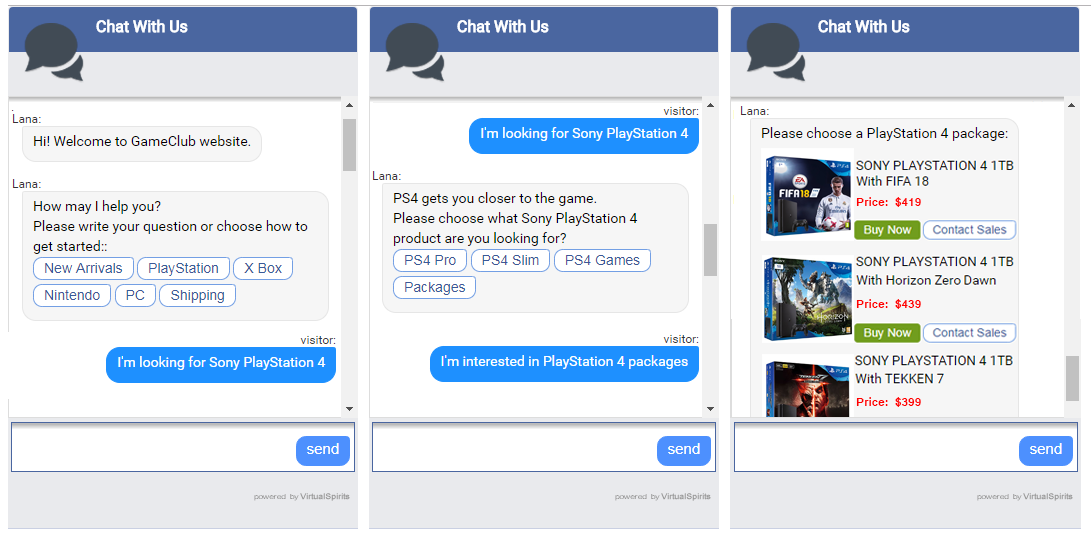
TOPICS:
Chatbot for Businesses Chatbot for Website Building a chatbot
Website Chatbot - Common Mistakes When Creating a Chatbot for Websites
A Website Chatbot allows business owners to realize the full potential of their website's traffic by having a 24/7 online presence. Chatbot can provide answers for commonly asked questions, help visitors navigate the website, reduce support costs and increase sales.
Yet when creating a Chatbot, it should be customized to each business and each website. Building a Chatbot without customizing it for your website may not get you the results you wished for and might even prevent you from using it again. On the other hand, some people are spending a lot of time in customizing their Chatbot, only to discover when lunching it online that the real visitors' conversation with the chat doesn't match the chat scripts they've written.
These are only some of the problems you might run into when building a Chatbot for your website. In this article we will look at some of the most common mistakes people make when creating Chatbots for websites and how to fix them and enjoy a well-functioning Chatbot.

Mistake #1 Chatbot is Missing a Clear Goal
You've decided to take action and improve your business’ customer service. You've done your research and decided that building a Chatbot for your website is the right solution for you. The Chatbot will answer your customers' questions automatically and decrease incoming calls to your support call center. In addition, you'll be able to transfer resources to other sections of your business.
But after writing answers for the commonly asked questions and adding the chat to your website your support call center is even busier than before. Your Chatbot is generating support leads for you and instead of reducing the incoming calls it's just creating more and more work. While trying to figure out why this is happening,you discover that your automatic chat is asking your visitors to leave their contact information and that a representative will call them back as soon as possible.
Your mistake was not setting the correct goal when creating the Chatbot for your website. Instead of providing instant answers to your visitors' questions your Chatbot is trying to generate as many sales leads as it can.
Solution:Define Your Chatbot's Goals and Customize it to Your Business Needs.
Chatbot is like a new employee in your company. If you don’t tell it exactly what it needs to do it will never be able to do its job properly. If you want your Chatbot to only provide instant answers, you should build a Chatbot for Customer Service and Support. If you want your Chatbot to help you get more sales and increase your conversion rate, you should build a Lead Generation Chatbot.
Chatbot for Customer Service and Support is designed to help visitors by answering their questions based on a large database of commonly asked questions, tags and keywords. This Chatbot’s goal is to help your visitors find the information they need, solve problems online and easily navigate the website. Chatbot for Customer Service and Support is not trying to get your visitors contact information.
Lead Generation Chatbot is designed to repeat its call-to-action during the conversation. Whether it is getting more sales leads or increasing online sales\registrations. This Lead Generation Chatbot will answer your visitors' commonly asked questions to remove obstacles and assist the sales process.
Mistake #2 Waiting for the Chatbot to be 'Perfect' Before Adding it to the Website
You want everything in your company to be functioning flawlessly. You've chosen the best web designers to build your website and gotten a highly-recommended SEO to bring traffic to your website. You find it important that your website reflects your perspective and that you'll be involved in every step in the process.
So, when building a Chatbot for your website, you want to be sure that you have covered any possible answer and every step in the conversation. You've spent hours adding FAQs, and having test-conversations with the chat to be sure it's behaving as you want.
After finally adding the Chatbot to your website,you keeping getting notifications about new questions that need to be answered. You find yourself adding more and more questions while wondering why you spent so much time when building your chatbot on adding answers if your visitors are asking completely different questions.
Solution:First you need to accept the fact that
you don't know. You don't know how your visitors will behave on your website, you don't know what questions they have and you don't know how they're going to formulate those questions.
Building a Chatbots for website is opening up a new world of information from your visitors that was previously hidden. By reading the Chatbot's conversations with real visitors you will find that they're asking questions that you didn't think of, looking for specific products and sometimes they may even point out things to improve in your website.
You can't cover all scenarios by yourself when creating the chatbot, and the best way to learn your visitors' needs is to let them point it out in a conversation. This way you can consistently improve your Chatbot, your website and your business.
Mistake #3 The Chatbot is a Robot – It Should Provide Robotic Answers
Some website owners' perception of Chatbots is that Chatbots are robots and should look and feel robotic; so when building the chatbot they add general answers and do not provide the customer any value.
For example: your Chatbot goal is to generate sales leads and visitors are asking "What is the price?" They get an answer that only links them to your pricing page. When reading the chat's conversations, you see that the visitors did get an answer for their pricing question but didn’t purchase nor generate a lead. This answer doesn’t givethe visitor any additional information regarding plans and pricing, or motivate them to leave their contact information.
Solution:You need to see the visitors' point of view while creating the chatbot for your website. When a potential customer is visiting your website he's looking for the product\service you're providing. All he needs is to get real information about your offer, get answers to his questions and remove any obstacles he has. The customer doesn’t care if the chat is automated or human. The Chatbot should provide him real information that helps him make a decision. The fact that the chat is automatic doesn’t make it unreal.
When you look at your most successful salesman you can see that every answer he provides is intended to move the customer along in the sale process. When building a chatbot for your website, use the Chatbot's answers to point out the benefits of your offer and motivate visitors to buy\register online or leave their contact information.
Mistake # 4 Adding the Chatbot to All of the Website's Pages
Not all of your website's visitors are in the same stage of the sales process, and not all of them intend to make a purchase. A common example is companies that deal with new and existing customers. This type of company’s homepage hosts all kinds of customers. For some of them it is the first time they're visiting the website while others are existing customers that need support or want to login to their account.
In the case of Lead Generation Chatbot for website, you expect your chat to push your visitors to provide their contact information so you can continue the sales process with a call\email. But because the chat was added to all of your website's pages, and some of the visitors are looking for customer service only, the automatic chat will generate some support leads. These support leads are not quality leads for your sales process and you don't want them.
Solution:Use the chat's report to check were the chat is getting the best results for you. The Chatbot should only work on pages where it has an effect on potential customers and provides the results you've asked for.
Once you have finished building the chatbot, you can start by adding the Chatbot to all of your website's pages, but you need to pay attention to the chat's activity and reports on different pages in order to find the pages with best results for your business needs. If needed, you should remove the chat form pages that are not relevant or pages where the results are bad for your business (i.e. generating support leads).
Mistake #5 Not Adding Chatbot to Mobile Website
In today's world the internet is available for everyone, everywhere, at any time. Smartphones are no longer a tool for making phone calls. These days every one of us has a small computer in his pocket. Case studies show an ongoing increase of visitors using their smartphones to search the for everything from weather to price comparisons. Every business must adjust his website to be mobile supported. Therefore, when building a chatbot for website you need to make sure you are not missing your mobile website traffic.
Solution:Most Chatbots are adapted for mobile and desktop users. Visitors are already using their smartphones during most of the day, and are used to chats from texting with their phones. Having a conversation with your Chatbot may be as natural for them as having a conversation in the family's WhatsApp group.
Ask your webmaster to add your Chatbot to your mobile website. This way you will make sure that you are not missing any potential customers. You should also check your chat activity on different pages of your mobile website and make adjustments if those are needed.
Mistake #6 Not Making Chatbot Optimizations
One of the greatest advantages of building a Chatbot for your website is the chat’s ability to collect valuable information from your customers and be constantly improved. A well-functioning Chatbot can increase its conversion rate as time goes by. The Chatbot is collecting all the data you need in order to improve it – use this data!
We talked about the Chatbot's ability to open up a whole new world of information about your customers that was previously hidden from you. But only adding answers to new questions asked by your visitors is not enough to significantly improve your chat. Sometimes you will add new answers but the results won't improve dramatically.
Solution:Use the information gathered from visitors’ real conversations with your Chatbot to improve it. Reading the visitors conversations, going over the chat's page reports, testing different types of introductions\scripts, reading visitors’ feedback for your answers, and looking for the key points in the conversations– all of these will help you to improve your Chatbot's results.
You can use this information for adding new answers, improving existing answers, changing the chat's settings and design and adjusting the chat's scripts. Just as you're always making sure that your website\Facebook page\LinkedIn account is up to date, make sure that your Chatbot is performing well and it can become your most valuable employee.